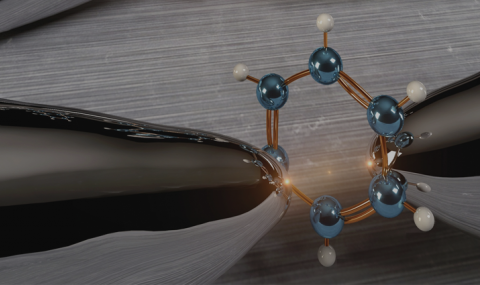We were able to turn on and off a Kondo many-body electronic system in a molecular junction by mechanical modifications of the metal-molecule interfaces. Thanks to this mechanical manipulation, we found that molecular vibrations have an enhanced effect on electron transport when a many-body electronic system is activated. This is an unknown, intriguing effect that has not been explained by theory (D. Rakhmilevitch et al. Physical Review Letters 113, 236603 (2014).
In molecules, electrons and vibrations are naturally coupled. So, by suspending a molecule between two electrodes in a molecular junction configuration, one can form an atomic-scale electro-mechanical system. Molecular junctions can also accommodate a Kondo system, a many-body electronic state in which the mobile electrons in the electrodes magnetically screen a single spin (or more), which is localized on the molecule. The Kondo effect is one of the most well studied many-body problems in physics, however the behavior of electron-vibration interaction in the presence of such correlated electronic system is poorly understood. We used a single molecule junction based on a Cu-phthalocyanine molecule embedded between two silver electrodes to reveal the properties of electron-vibration interaction in the presence of a Kondo-correlated electron state.
At a sufficiently high voltage, the injected electrons have the necessary energy to excite a certain vibration mode at the molecular junction. This process promotes a vibration-assisted Kondo transport for which the excess energy of the injected electrons due to the applied voltage is released to activate a vibration mode, allowing the inelastic electrons to participate in the Kondo transport, which usually takes place at zero applied voltage. Vibration-mediated Kondo effect was suggested in various former experimental studies as a probable origin for different spectroscopic features. However, this interpretation was not fully verified. As a first step, we took advantage of several independent observations to establish an experimental confirmation for the existence of this process. Our findings are also supported by ab initio calculations done by the group of Ferdinand Evers.
Furthermore, despite extensive theoretical interest in the vibration-mediated Kondo effect, the properties of this process were never analyzed experimentally. Following the identification of such a Kondo effect in our molecular junction, we studied its properties and revealed: (1) remarkably similar Kondo temperatures (in the limit of our sensitivity) for both the standard Kondo process observed in our system and the vibration-mediated Kondo process; and (2) a surprisingly large electron-vibration interaction when a Kondo process is activated. The latter observation was obtained using our ability to switch the Kondo process “on” and “off” by mechanical means.
These new experimental findings are expected to promote a better understanding of electron-vibration interaction in the presence of correlated electrons and further theoretical activity in this direction.


